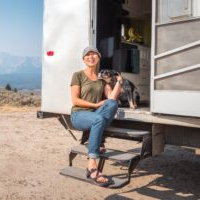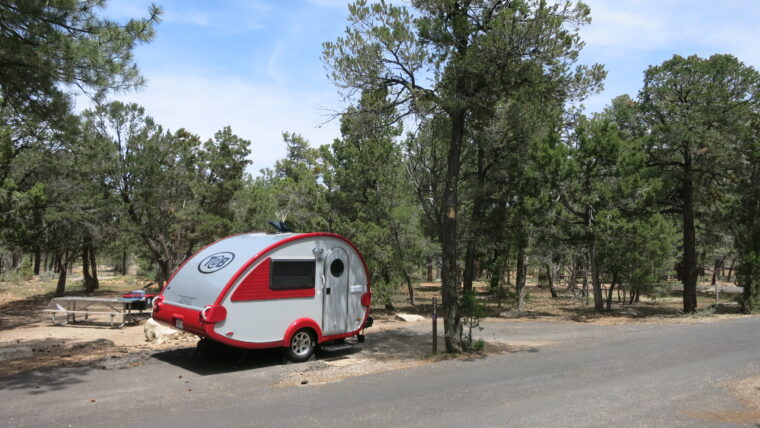California is home to the most national parks of any state, nine in total. Yosemite, Death Valley, Sequoia, and Joshua Tree are the Golden State’s most iconic parks, seeing millions of annual visitors due to their popularity and size. This doesn’t mean the lesser-known national parks are any less worthy of a visit. Instead, fewer crowds and more camping availability make them more appealing.
5 California National Park RV Trips to Take This Summer and Fall
Channel Islands National Park
Channel Islands National Park, located less than 30 miles from mainland Santa Barbara, is a collection of five islands with 175 miles of untouched coastline. Accessible by a ferry or private boat, the islands can only be explored by foot or sea kayak. In 2021, 319,252 people visited this rugged park, eager to see mountains with rare Torrey pines, sandstone canyons, and sea caves, or hike out to Point Bennett to see huge rookeries of seals and sea lions on the remote beach. Half of this national park is underwater, making snorkeling an exciting way to see the diverse marine environment.
Where to Camp
Each island has its own primitive campground, open year-round to backpackers, with amenities like pit toilets, picnic tables, and food storage bins that campers must use. Reservations are required and water is only available at Santa Rosa and Santa Cruz Island campgrounds. Pets aren’t allowed on any island. Reservations can be made 6 months in advance through Recreation.gov.
RVers who plan to camp on an island will receive an overnight parking pass after booking their ferry ride with Island Packers, the park’s concessionaire boat company. Day visitors can stay at either Ventura Beach RV Resort or Waypoint Ventura, both close to the park’s Ventura visitor center and ferry location.

Lassen Volcanic National Park
The landscape at Lassen Volcanic National Park, the 15th national park to be established in the U.S., is as diverse as they come. The snow-covered Lassen Peak volcano rises high above the valley floor dotted with alpine lakes and steaming fumaroles. Snowshoes and cross-country skis are an excellent way to explore the park, which sits at 6,000 feet in elevation, in the winter. Bumpass Hell—the largest hydrothermal area in the park, with mud pots and boiling pools—is only accessible in the summer and fall. The park received 359,635 visitors in 2021.
Where to Camp
Manzanita Lake, Butte Lake, and Summit Lake campgrounds are best suited for RVs. They’re only open a few months out of the year and don’t have hookups, but water is available seasonally. Each site has a picnic table, fire ring, and food storage locker. Manzanita Lake Campground is the largest with 179 sites, showers, flush toilets, a dump station, and spaces for 40-foot RVs. According to the National Park Service (NPS), reservations are highly recommended from July through early September, and can be made on Recreation.gov up to 6 months in advance. Pets are only welcome at campgrounds, paved roads, parking lots, and picnic areas.
Lassen National Forest and Bureau of Land Management lands surround the national park, offering boundless dry camping options in places such as Hat Creek Campground. Burney Fall-Hat Creek KOA and other RV parks with full hookups and sites for big rigs aren’t far from this national park.
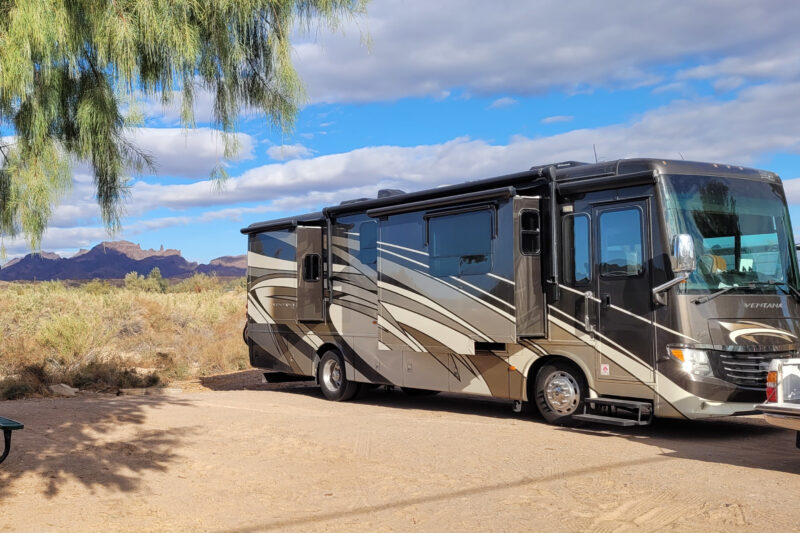
Pinnacles National Park
Situated 2 hours south of San Francisco, Pinnacles National Park is the smallest park out of this group. Its unique landscape of rock towers and talus caves is the result of volcanic eruptions from millions of years ago. This relatively new park received 348,857 visitors in 2021, its busiest year so far. People come hoping to glimpse the long wingspans of the once-endangered California condors along High Peaks Trail or to hike into Bear Gulch Cave, home to a colony of big-eared bats.
Where to Camp
Pinnacles Campground is located at the east entrance of the park and is the only camping option inside the park. The 134-site, pet-friendly campground is big rig friendly, open year-round, and requires reservations. There are 25 RV sites, some with 30-amp electric hookups. The campground offers flush toilets, showers, potable water, and a dump station. There’s also a pool that’s typically open seasonally from April to September—a welcome sight on 100-degree days. Reservations can be made up to 6 months in advance on Recreation.gov.
Yanks RV Resort, located outside of the park’s west entrance, and San Benito Thousand Trails, located near the east entrance, both offer full hookups and are convenient options when the park campground is full. There aren’t any roads that connect the two entrances inside the park.
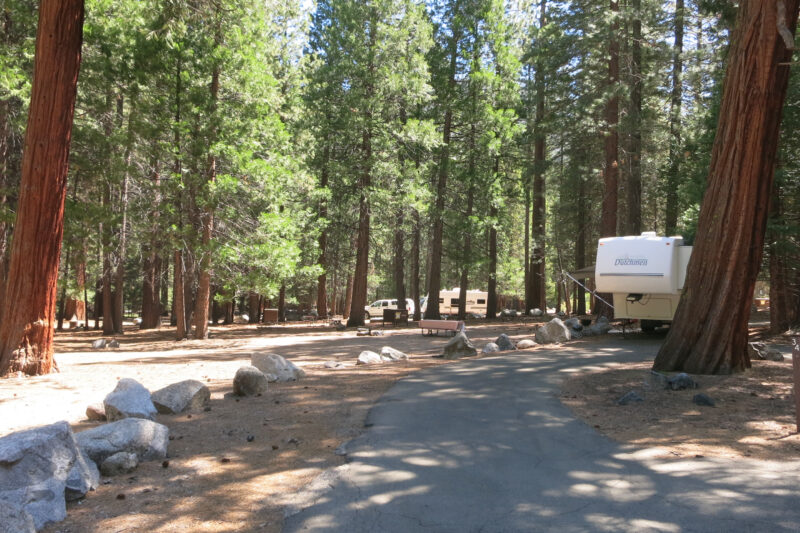
Kings Canyon National Park
With a landscape that rivals Yosemite National Park and only 562,918 visitors in 2021—compared to Yosemite’s 3.3 million—Kings Canyon National Park is a hidden gem. The NPS refers to this park as “a land of giants” because of the towering granite walls, a canyon that’s deeper than the Grand Canyon, and the largest remaining groves of sequoia trees. Be prepared to crane your neck in awe as you stroll through Grant Grove appreciating magnificent giants like the General Grant Tree. Kings Canyon is adjacent to busier Sequoia National Park but there’s only one entrance fee to visit both. There are RV size restrictions on some roads in both parks.
Where to Camp
There are six campgrounds—Azalea, Sentinel, Sheep Creek, Moraine, Crystal Springs, and Sunset—that welcome RVs up to 25 feet long. Sentinel has sites for larger rigs and Azalea is the only campground that’s open year-round. Reservations are required, except at Azalea during the off-season, and can be made at Recreation.gov up to 1 month in advance. Pets are welcome at each campground.
If you’d rather stay outside the park, there are many boondocking options in Sequoia National Forest. Princess Campground doesn’t offer hookups, but has flush toilets and a dump station. Nearby RV parks are limited, but Campendium users give Sequoia RV Park a 5-star rating.
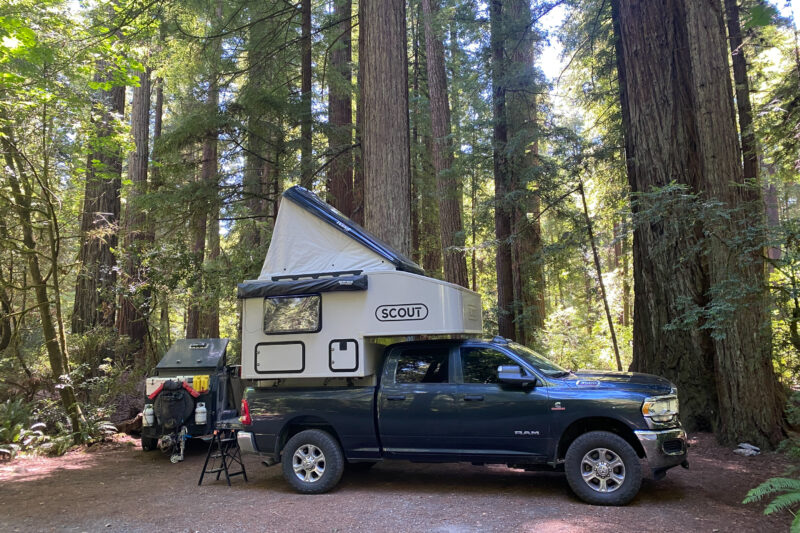
Redwood National Park
This Northern California World Heritage Site is famous for its redwoods, the world’s tallest trees, so it’s easy to forget that there’s more to see in the park. There are 40 miles of rocky coastline, lupine-filled prairies, and winding rivers in the park, which only saw about 436,000 visitors last year. Cycling through the old-growth forest is a great way to see the park, and the NPS offers seven bike routes. Pets are welcome on Crescent and Freshwater beaches in addition to developed campgrounds, some scenic viewpoints, and roads.
The Best Campgrounds Near Mountain Biking Trails
Where to Camp
There are four campgrounds to choose from when visiting Redwood, all of which are in the three state parks located within the national park boundary. Each has sites that can accommodate motorhomes up to 27 feet and trailers up to 24 feet. Mill Creek Campground is the only campground that’s open seasonally, and reservations are recommended for all campgrounds. No campgrounds at Redwood have hookups, but Jedediah Smith and Mill Creek offer dump stations. Jedediah Smith, Mill Creek, and Elk Prairie Campground offer hot showers and flush toilets. Golds Bluffs Beach Campground has basic amenities but doesn’t allow trailers due to the unpaved road in.
There are vehicle type and size restrictions on roads throughout this national park. It’s a good idea for larger rigs to stay at an RV park in town, like Golden Bear RV Park, which has full hookups and waterfront sites. There are national forest camping options galore, such as Panther Flat Campground, which might be a better fit for some rigs.
Put your America the Beautiful pass to use this year and take a road trip to one or all of these five stunning national parks in California.

